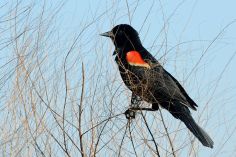On the wild side—April, 2013
by Tina Mitchell
Among North America’s most familiar and abundant birds, Red-winged Blackbirds seem to sing  their “konk-a-REE” songs in every marsh and wet field from one coast to the other. The adult male looks as distinctive as the female looks confusing. Mature males (left) are glossy black with eponymous yellow-trimmed red epaulets on their shoulders. (This red can’t always be seen, since it remains concealed by body feathers on non-displaying
their “konk-a-REE” songs in every marsh and wet field from one coast to the other. The adult male looks as distinctive as the female looks confusing. Mature males (left) are glossy black with eponymous yellow-trimmed red epaulets on their shoulders. (This red can’t always be seen, since it remains concealed by body feathers on non-displaying birds.) The mostly gray-brown, seriously streaky females (right) seem to be almost woven out of the rushes they often frequent. Females and immature males usually have a prominent, pale eyebrow above the eye. Because of their dusky, streaking coloring, females can be confused with sparrows; however, since few 8-inch sparrows fly around out there, the female Red-winged’s size provides a good identification hint.
birds.) The mostly gray-brown, seriously streaky females (right) seem to be almost woven out of the rushes they often frequent. Females and immature males usually have a prominent, pale eyebrow above the eye. Because of their dusky, streaking coloring, females can be confused with sparrows; however, since few 8-inch sparrows fly around out there, the female Red-winged’s size provides a good identification hint.
Find a cattail marsh and you’ll usually find Red-wingeds. Yet they can utilize a wide variety of habitats. In fact, in the first Colorado Breeding Bird Atlas, marshes and other aquatic areas accounted for less than 60% of the breeding habitats; agricultural lands and croplands contributed another 28%. Red-winged Blackbirds employ a seasonal dietary switch: a
Although ¾ of their diet annually consists of grain and seed, they eat mainly insects in summer, including beetles, caterpillars, grasshoppers, spiders, and millipedes. If they’re in your area, they’ll also happily flock to your bird feeders.
In our area, most—but not all—Red-wingeds migrate a bit further south for the winter, typically in October. In spring, males return to breeding grounds in February and March, generally 2 weeks ahead of the females. Their breeding season in Colorado lasts 4½ months, from mid-April to late August, during which most Red-wingeds produce at least 2 broods—and even 3, for the highly motivated and fast workers. Often gathering in large colonies, males claim territories using aggressive chases and calls. Displaying males sit conspicuously on rushes, wires, fences—whatever high point they can find nearby—spreading their wings and flashing their namesake red patches for all to see. Males practice polygyny: Up to 15 females may breed within one male’s territory, although the average size of his harem tends to be five or fewer females. This polygynous breeding leaves many males, especially first-year birds, without mates each breeding season. Built by the female, the nest resembles a bulky open cup of grass, reeds, and leaves, lashed to surrounding vegetation. The female lays 3 – 5 eggs and handles the incubation all on her own until the eggs hatch between 10 and 13 days later. She also feeds the nestlings, although the male occasionally pitches in a mouthful or 2. Both males and females aggressively defend nests (and young) against intruders by hovering overhead and calling loudly. Notably bold, several will not hesitate to attack a larger bird such as a hawk or crow that flies over their nesting area—or a human who walks too close (as I know from up-close-and-personal experience). Young leave the nest about 11 – 14 days after hatching; the female feeds the fledglings for another 2 weeks before starting a second brood.
The derivation of the common name of this black bird with red wing epaulets should need little explanation. But the scientific name of the Red-winged Blackbird—Agelaius phoeniceus—has some interesting roots. In winter, some male Red-wingeds may remain in their breeding areas; but those that migrate often gather en masse—sometimes in HUGE masses, numbering in the thousands—in grain fields and feedlots. This dramatic flocking characteristic gave them their scientific name: Agelaius evolved from the Greek word for “belonging to a flock.” Even the genus name has an interesting derivation. Phoeniceus comes from phoinikeos, which is Greek for a dull scarlet. Ancient Phoenicians brought this dye color, made from shellfish, to the Greeks; they honored that sharing by naming the color after them.
Remember Sing a song of sixpence with its “4 and 20 blackbirds baked in a pie?” You might think this rhyme refers to eating blackbirds as we know them. However, the English blackbird is more closely related to our American Robin than to our blackbirds. Since members of the Thrush family, such as robins, eat a lot of fruit, rather than seeds or insects, they were considerably tastier than many other songbirds. Thank goodness the Migratory Bird Treaty Act of 1918 put an end to legal songbird eating in North America.
Red-winged Blackbirds are members of the large Icterid family, which includes grackles, meadowlarks, bobolinks, cowbirds, and orioles. You can learn more about this epaulet-bearing flocking bird and hear snippets of its song and calls here.
